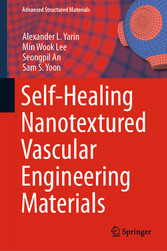Suchen und Finden
Service

Self-Healing Nanotextured Vascular Engineering Materials
Alexander L. Yarin, Min Wook Lee, Seongpil An, Sam S. Yoon
Verlag Springer-Verlag, 2019
ISBN 9783030052676 , 271 Seiten
Format PDF, OL
Kopierschutz Wasserzeichen
Geräte
Preface
6
Contents
10
About the Authors
14
1 Introduction
16
1.1 Nature-Inspired Biomimetic Self-Healing for Self-sustained Mechanical Properties
17
1.2 Self-Healing: Extension to Corrosion Protection
19
1.3 Capsule-Based Approach to Self-Healing
20
1.3.1 Microcapsules Filled with Healing Agents
21
1.3.2 Nanoscale Capsules Filled with Healing Agents
23
1.4 Tube and Channel Networks and Microfibers
24
1.5 Sacrificial Materials and Shape-Memory Polymers
31
References
33
Materials and Fundamental Physicochemical Phenomena
37
2 Healing Agents Used for Mechanical Recovery in Nanotextured Systems
38
2.1 Dicyclopentadiene (DCPD) and Grubbs’ Catalyst
38
2.2 Poly(Dimethyl Siloxane) (PDMS)
39
2.3 Other Elastomers
39
2.4 Bisphenol-A-Based Epoxy and Other Types of Epoxy
44
2.5 Gels
46
References
46
3 Macroscopic Observations of Physicochemical Aspects of Self-Healing Phenomena
50
3.1 Spreading of Released Drops of Healing Agents on Horizontal Surfaces
50
3.1.1 Experimental Observations
51
3.1.2 Wetting of Self-Healing Agents on Porous Electrospun NFs
53
3.1.3 Coalescence of Droplets of Self-Healing Agents on Porous Electrospun NFs
55
3.1.4 The Hoffman–Voinov–Tanner Law and Droplet Footprint Spreading on Wettable Intact Surfaces and NF Mats
58
3.1.5 Coalescence of Droplets on NF Mats
64
3.2 Spreading on Tilted Surfaces
68
3.3 Filling of Crack Tips
75
3.3.1 Macroscopic View of Epoxy Release and Hardening
75
3.3.2 Epoxy-Hardener Reaction Observed in a Macroscopic Crack-Tip-Shaped Mold
76
3.4 Stitching Cracks and the Corresponding Mechanical Properties
78
3.4.1 Macroscopic Model of Self-Healing Composite Materials with Embedded Microchannel System
78
3.4.2 Release and Mixing of Healing Agents
80
3.4.3 Wettability-Driven Spreading and Polymerization of Healing Agents
81
3.4.4 Recovery of Mechanical Strength
82
References
85
Fabrication Methods
88
4 Fabrication of Vascular Nanofiber Networks with Encapsulated Self-Healing Agents for Mechanical Recovery
89
4.1 Electrospinning
89
4.1.1 Charge Relaxation Time in Electrolytes
89
4.1.2 Formation of Electrospun Polymer NFs
91
4.2 Co-electrospinning
96
4.3 Emulsion Spinning
101
4.4 Solution Blowing
110
4.5 Coaxial Solution Blowing
112
4.6 Emulsion Blowing
118
4.7 Two- and Three-Dimensional Self-Healing Materials
121
4.7.1 Two-Dimensional Planar Self-Healing Composites
121
4.7.2 Three-Dimensional Self-Healing Composites
124
References
129
5 Characterization of Self-Healing Phenomena on Micro- and Nanoscale Level
132
5.1 Visualization
132
5.2 Spectroscopic Characterization
133
5.3 Thermal Analysis
141
References
144
Mechanical Behavior of Self-Healing Nanotextured Materials
146
6 Failure, Cracks, Fracture, Fatigue, Delamination, Adhesion, and Cohesion
147
6.1 Failure Criteria
147
6.2 Cracks in Brittle Elastic-Plastic Media
149
6.3 Cracks in Viscoelastic Media
154
6.4 Fatigue Cracks
157
6.5 Critical Catastrophic Crack and Subcritical Crack Propagation
160
6.6 Delamination Cracks
164
6.7 Adhesion and Cohesion Energy: Stiff Materials
166
6.8 Adhesion and Cohesion Energy: Soft Materials
169
References
171
7 Self-Healing of Mechanical Properties: Evaluation by Tensile Testing
174
7.1 Tensile Testing: Stiffness Recovery in Composites with Co-electrospun Polyacrylonitrile–DMS Resin Monomer–Curing Agent Nanofibers
174
7.2 Tensile Testing: Stiffness Recovery in Composites with Solution-Blown PVDF/PEO/Epoxy/Hardener NFs
181
7.3 Strength Recovery Under Static Fatigue Conditions
188
7.4 Dynamic Situation: Mode I Crack Propagation
193
References
202
8 Self-Healing at Ply Surfaces: Adhesion, Cohesion, and Interfacial Toughening Evaluated Using Blister and Impact Tests
204
8.1 Blister Testing: Recovery of Adhesion or Cohesion in Composites with Co-electrospun PAN/DMS-Resin/Curing Agent NFs
204
8.2 Blister Testing: Recovery of Adhesion or Cohesion in Composites with Solution-Blown PVDF/PEO/Epoxy/Hardener NFs
212
8.3 Double-Cantilever Beam and Bending Tests
217
8.3.1 Double-Cantilever Beam Test
217
8.3.2 Bending Test
218
8.4 Interfacial Toughening Due to NFs: Intrinsic Versus Extrinsic Toughening and Self-Healing Characterized by Impact Testing
220
8.5 Cumulative Results on Mechanical Recovery of Self-Healing Vascular Materials
224
8.6 Self-Healing of Three-Dimensional Materials
228
References
234
Self-Healing Nanotextured Materials for Corrosion Protection
238
9 Capsule-Based Self-Healing Approaches for Corrosion Protection
239
9.1 Electrochemical Fundamentals of Corrosion Cracking of Metals
239
9.2 Healing Agent-Embedded Capsule-Based Self-Healing
242
9.3 Modified Healing Agents and Microcapsules
243
9.4 Corrosion Inhibitor-Embedded Capsule-Based Self-Healing
246
References
250
10 Fiber-Based Self-Healing Approaches for Corrosion Protection
253
10.1 Corrosion Protection Provided by Coatings with Embedded Core-Shell NFs Formed by Co-Electrospinning
253
10.2 Corrosion Protection Provided by Coatings with Embedded Core-Shell NFs Formed by Emulsion Spinning
256
References
259
11 Concluding Remarks and Future Perspectives
260
11.1 Advantages and Disadvantages of Self-Healing Engineering Materials and Future Research Directions
260
References
262
Index
263
Shop


